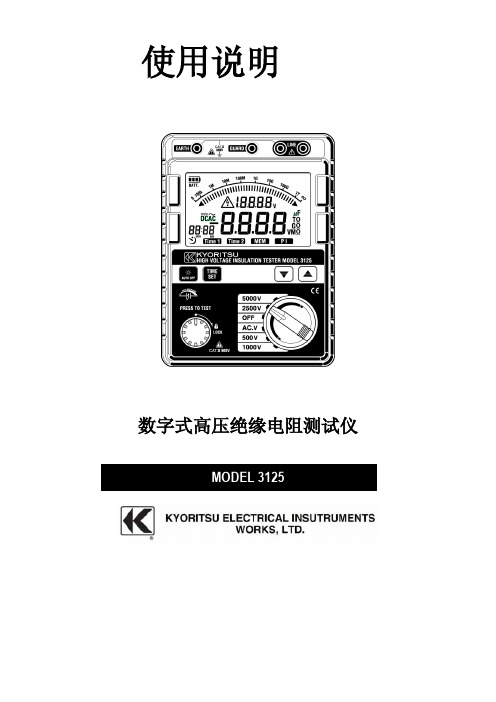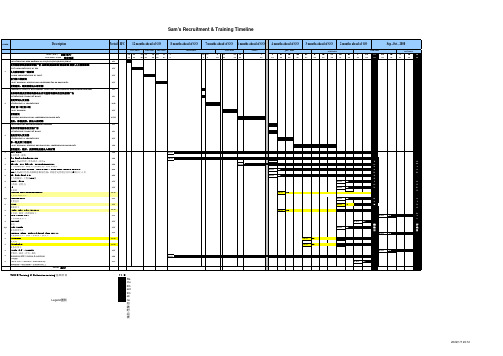HRM3125 week14 10-11
- 格式:ppt
- 大小:295.00 KB
- 文档页数:32

Phone: 440-248-1200 • Fax:440-248-5426LABORATORYGRADE INSTRUMENTSTHRULINE ®High-Accuracy RF Power MeterOur Model 4421 power meter is an excellent choice for demanding calibration,process control and scientific applications. It directly measures power with anaccuracy of ±3% of reading without calibration charts, couplers, attenuators, or other external equipment which can degrade accuracy.The backlit 31⁄2-digit LCD displays forward and reflected power in either wattsor dBm, VSWR, return loss in dBm and Minimum or Maximum values. Ranging is selectable manual or autoranging. An optional GPIB or RS-232 computer interface can be used with the Model 4421 during AC operation.Smart Power Sensors (see below) are required for operation. Each covers an extended frequency and power range. The microprocessor based sensors contain nonvolatile memory to store calibration data, and can easily be recalibrated in the field.Power Range: 100 mW to 10 kW FS Frequency Range: 100 kHz to 2.5 GHz VSWR Range: 1.0 – 199.9Functions: Forward and reflected power in W or dBm, VSWR, return loss in dB and min/max values Ranging: Selectable manual or autoranging. Power sensor dependent.Overrange Indication: Audible warning when RF power input exceeds 120% of sensor’s maximum power range.Display: 31⁄2digit-liquid crystal display with annunciator for mode, measurement units, battery condition, programming status, and trend arrows. Switchable backlight.Operating Power: AC mains or batteries. 115/230 Vac, 50/60 Hz or 8 nickel cadmium 1.2 V C cells (NEDA type 10014).Nominal Size: 129⁄32" L ×125⁄32" W ×41⁄4" H (312 mm x 309 mm ×108 mm) with handle extended 157⁄16"L (392 mm)Weight: 11 lbs. (5 kg.)Interconnects: 1 meter latch-n-lok coiled cable.Interfaces: Optional field-installable IEEE-488 (PN: 4421-488) or RS-232 serial interface (PN: 4421-232). Dimensions: 41⁄2" ×61⁄2" (114 ×165 mm)Required Product: Order a Smart RF Power Sensor below Recommended Accessories: Case (page 7)Circuitry: Microprocessor-based measurement and conversion.Frequency/Power Coverage: Single power sensor covers specified power and frequency range.Bi-directional Operation: Pick up of RF power in precision 50-ohm line.Accuracy: ±3% of reading from rated maximum range down to 30% of full scale on the most sensitive range.Signal Purity: For rated accuracy, no more than 1% AM; harmonics –50 dB or less.Calibration T echnique: Calibration vs frequency curve stored in nonvolatile memory withineach sensor. Sensor output corrected at fre-quency of measurement within rated stage.Sampling Rate: Approximately 2 readings/second.Ambient T emperature Range: Temperature compensated for rated accuracy from 0˚C to 50˚C (32˚F to 122˚F).Connectors: QC-type. Female N normally supplied; Other coaxial-type connectors available on page 60.Nominal Size: (includes connectors) 57⁄32" L ×21⁄2" W ×31⁄4" H (132.5 mm ×64 mm ×83 mm).Weight: 1 lb. 11 oz. (0.76 kg).。

Human Resource ManagementCourse Code:050232BCourse Name:Human Resource ManagementPeriods:32Credits:2Name(s) of academic staff:Wei Hua-yingPreparatory Courses:Learning outcomes(1)Define the roles and activities of a company's human resource managementfunction.(2)Discuss how to strategically plan for the human resources needed to meetorganizational goals and objectives.(3)Define the process of job analysis and discuss its importance as a foundationfor human resource management practice.(4)Compare and contrast methods used for selection and placement of humanresources.(5)Describe the steps required to analyze, develop, implement, and evaluate anemployee training program.(6)Identify and explain the issues involved in establishing compensationsystems.(7)Identify how new technology, such as digital and social media, is influencinghuman resource management.(8)Discuss what companies should do to compete in the global marketplace.(9)Identify the importance of the process of human resource managementfunctions in small businesses and entrepreneurial firms.Course DescriptionThis course is an introduction to the human resource management (HRM) function and related elements and activities to examine the role of the human resource professional as a strategic partner in managing today’s organizations. Key functions such as recruitment, selection, development, performance management, appraisal, retention, compensation, and labor relations are examined. Implications of the legal and global environments are examined and current issues such as employee engagement and employee health and safety are analyzed. Emphasis is placed on the modern day importance of HRM at the corporate level as well as the importance ofHRM in small businesses and entrepreneurial firms.●Mode of deliveryLecture and Tutorial.●Content outline of the subject and learning time per topicLecture OutlineChapter 1 Introduction to Human Resource Management (1)What Is Human Resource Management?(2)The Trends Shaping Human Resource Management (3)Today’s New Human Resource Management(4)The New Human Resource Manager(5)The Plan of This Book(6)Chapter Contents Overview(7)The Topics Are InterrelatedChapter 2 Equal Opportunity and the Law(1)Equal Opportunity Laws Enacted From 1964 to 1991(2)The Laws Enacted from 1991 to the Present(3)Defenses Against Discrimination Allegations(4)The EEOC Enforcement Process(5)Diversity ManagementChapter 3 Human Resource Management Strategy and Analysis(1)The Strategic Management Process(2)Types of Strategies(3)Strategic Human Resource Management(4)HR Metrics, and Benchmarking, and Data Analytics(5)High-Performance Work Systems(6)Employee Engagement Guide for Managers: Employee Engagement and Performance.Chapter 4Job Analysis and the Talent Management Process(1)The Talent Management Process(2)The Basics of Job Analysis(3)Methods for Collecting Job Analysis Information(4)Writing Job Descriptions(5)Writing Job Specifications(6)Employee Engagement Guide for Managers(7)Using Competencies ModelsChapter 5 Personnel Planning and Recruiting(1)Workforce Planning and Forecasting(2)Why Effective Recruiting Is Important(3)Internal Sources of Candidates(4)Employee Engagement Guide for Managers(5)Outside Sources of Candidates(6)Recruiting a More Diverse Workforce(7)Developing and Using Application FormsChapter 6Employee Testing and Selection(1)Why Employee Selection Is Important(2)The Basics of Testing and Selecting Employees(3)Types of Tests(4)Work Samples and Simulations(5)Background Investigations and Other Selection MethodsChapter 7Interviewing Candidates(1)Basic Types of Interviews(2)Avoiding Errors That Can Undermine an Interview’s Usefulness (3)How to Design and Conduct the Effective Interview(4)Employee Engagement Guide for Managers(5)Developing and Extending the Job OfferChapter 8Training and Developing Employees(1)Orienting and Onboarding New Employees(2)Employee Engagement Guide for Managers: Onboarding at Toyota (3)Overview of the Training Process(4)Implementing the Training Program(5)Implementing Management Development Programs(6)Managing Organizational Change Programs(7)Evaluating the Training EffortChapter 9Performance Management and Appraisal(1)Basics of Performance Appraisal(2)Techniques for Appraising Performance(3)Dealing with Rater Error Appraisal Problems(4)Managing the Appraisal Interview(5)Employee Engagement Guide for Managers(6)Performance ManagementChapter 10Managing Careers and Retention(1)Career Management(2)Employee Engagement Guide for Managers(3)Managing Employee Turnover and Retention(4)Employee Life-Cycle Career Management(5)Managing DismissalsChapter 11Establishing Strategic Pay Plans(1)Basic Factors in Determining Pay Rates(2)Job Evaluation Methods(3)How to Create A Market-Competitive Pay Plan(4)Pricing Managerial and Professional Jobs(5)Contemporary Topics in Compensation(6)Employee Engagement Guide For ManagersChapter 12Pay for Performance and Financial Incentives(1)Money’s Role in Motivation(2)Individual Employee Incentive and Recognition Programs(3)Incentives for Salespeople(4)Incentives for Managers and Executives(5)Team and Organization-Wide Incentive Plans(6)Employee Engagement Guide for ManagersChapter 13Benefits and Services(1)Introduction: The Benefits Picture Today(2)Pay for Time Not Worked(3)Insurance Benefits(4)Retirement Benefits(5)Personal Services and Family-Friendly Benefits(6)Flexible Benefits Programs(7)Employee Engagement Guide For ManagersChapter 14Building Positive Employee Relations(1)What is Employee Relations?(2)Employee Relations Programs For Bu ilding And Maintaining Positive Employee Relations(3)The Ethical Organization(4)Managing Employee Discipline(5)Employee Engagement Guide For ManagersChapter 15Labor Relations and Collective Bargaining(1)The Labor Movement(2)Unions And The Law(3)The Union Drive and Election(4)The Collective Bargaining Process(5)Dealing With Disputes And Grievances(6)The Union Movement Today And TomorrowChapter 16Safety, Health, and Risk Management(1)Introduction: Safety and the Manager(2)Manger’s Briefing on Occupational Safety Law(3)What Causes Accidents?(4)How to Prevent Accidents(5)Employee Engagement Guide for Managers(6)Workplace Health Hazards: Problems and Remedies(7)Occupational Security and Risk ManagementChapter 17Managing Global Human Resources(1)The Manager’s Global Challenge(2)Adapting Human Resource Activities to Intercountry Differences (3)Staffing the Global Organization(4)Training and Maintaining Employees Abroad(5)Employee Engagement Guide for Managers(6)Managing HR Locally: How to Put into Practice a Global HR SystemChapter 18Managing Human Resources in Small and Entrepreneurial Firms (1)The Small Business Challenge(2)Using Internet and Government Tools to Support the HR Effort(3)Leveraging Small Size with Familiarity, Flexibility, Fairness and Informality(4)Using Professional Employer Organizations(5)Managing HR Systems, Procedures, and Paperwork●Assessment:Final Examination 60%; Attendance 20%; Group Assignment 20%.●ReferencesMain references:Gary Dessler (2016) Human Resource Management, 15th Edition, London: Pearson。

使用说明数字式高压绝缘电阻测试仪目录1.安全警告2.特点3.技术规格4.仪器布局4-1 仪器布局4-2 液晶屏显示5. 测试前的准备5-1 检查电池电压5-2 连接测试导线6. 测试6-1 断电确认(电压测量)6-2 绝缘电阻的测量6-3 连续测量6-4 定时器测量功能6-5 极化指数测量(任意时间设定)6-6 测量端口的电压特性6-7 保护接线的使用6-8 背光功能6-9 自动关机功能7.电池更换8、附件8-1 测试探棒的金属部分和更换8-2 记录仪适配器8-3 鳄口夹测试线1.安全警告本仪器的设计、制造和检测均达到IEC61010安全标准(电子类测量产品安全要求),本说明书包括确保仪器的安全使用及保证仪器的安全状态,使用者所必须遵守的警告和安全条例。
使用前请先阅读以下说明。
警告 ● 使用前,通读并理解说明书中的操作指南。
● 请将说明书随身保存以确保可随时参阅。
● 必须按指示使用仪器。
● 理解并遵守安全操作指示。
必须严格遵守上述操作说明。
如不遵守,测量时可能会导致人身伤害和仪器毁坏。
本仪器上的标志 意思是指为了安全操作本仪器,请使用者参照使用手册的相关部分操作。
以上的电路中测量。
若仪器出现异常请停止使用。
例如:仪器破损或裸露出金属部分。
符号测量前,确认量程开关切换至适当的位置。
2. 特点MODEL3125是由电子控制的4个量程测量绝缘电阻的高压绝缘电阻计。
● 设计达到以下安全标准:IEC 61010-1(CAT.III 600V 污染度2)IEC 61010-031(手持式探针要求标准)● 自动放电功能:测试电容性负荷的绝缘电阻时,测量后自动释放充电电荷。
放电状态可在电压模式中确认。
● 背光功能便于在阴暗光线或夜间工作。
● 条形图显示测量结果。
● 带电线路警告标志和蜂鸣警告。
● 自动关机功能:为避免忘记关机造成的电池浪费,测量后10分钟无操作时仪器将自动关机。
● 设定测试时间功能:在指定时间里自动执行测量。


